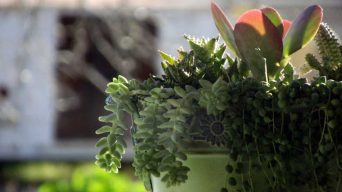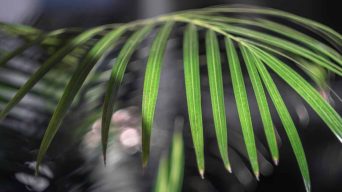Majesty Palm is a versatile plant suitable for both indoor and outdoor use. When grown indoors, it needs low-light conditions. It can be placed on shaded decks or patios outdoors but shouldn’t be exposed to hot, sunny situations. The plant can’t tolerate cold temperatures, so it should be brought indoors during winter.
The Majesty palm is a beautiful and hardy tropical plant that can make any home or garden look lush.
But the question remains—is it better to keep Majesty palms indoors or outdoors?
This blog post will discuss the pros and cons of keeping Majesty palms in either environment and how to best care for them.
Whether you’re looking for an indoor plant to brighten up your living space or a robust outdoor addition, this article will help you decide if Majesty palms are right for you.
Understanding Majesty Palms
Majesty palms, also known as Ravenea rivularis, are a type of tropical palm tree native to Madagascar.
These majestic plants can grow up to 10 feet tall indoors and 80 feet outdoors.
With their graceful, feathery fronds and symmetrical leaves, Majesty palms make a stunning addition to any home or garden.
Majesty palms have large, untidy crowns with long, arching fronds that can reach up to 6 feet in length.
The leaves are bright green and glossy in appearance, and the trunk is slender and smooth.
As they mature, Majesty palms develop a thick brown bark that adds texture and interest to the plant.
Growth Pattern
Majesty palms are slow-growing plants that require careful attention to thrive indoors.
They prefer warm temperatures between 65-75°F (18-24°C).
Majesty palms should be kept in a bright location away from direct sunlight to encourage healthy growth.
Majesty palms prefer high humidity levels, so it’s important to mist them regularly and provide adequate air circulation.
When given adequate light and water, Majesty palms will grow slowly but steadily over time.
Light and Water Needs
Majesty palms need bright indirect sunlight for the best growth. Too much direct sunlight can cause the leaves to burn or turn yellow.
It’s important to keep the soil evenly moist but not soggy; allow the top inch of soil to dry out before watering again.
During winter months, when growth slows down, reduce watering frequency accordingly.
Maintenance
To maintain the optimal appearance of your Majesty palm tree, it is crucial to consistently eliminate fronds that are dead or damaged, as well as any palm leaves that may become yellowed over time.
Fertilize every two weeks during the growing season (spring and summer) with a balanced liquid fertilizer diluted at half strength for optimal growth.
Pros and Cons of Indoor Majesty Palms
Growing Majesty palms indoors has its advantages and disadvantages. Knowing them can help you make the best decision.
Benefits
- Aesthetics – Majesty palms make a beautiful and graceful addition to any home or office. Their large, frondy leaves can instantly bring a sense of Majesty and life to any space. Its thick trunk and branches add texture, while its glossy leaves offer a touch of elegance.
- Easy to Maintain – Indoor palms are relatively easy to take care of as long as they get enough light and water. They also don’t require a lot of pruning or maintenance, making them great for busy homeowners who want an attractive, low-maintenance houseplant.
- Purify Indoor Air – Majesty palms are great at purifying indoor air, removing toxins like formaldehyde and benzene from the environment. This makes them a great choice for people who want to improve indoor air quality without investing in costly air purifiers or filters.
Limitations
- Limited Growth Potential – Majesty palms are slow-growing plants and can’t reach their full potential when grown indoors. This means they may not get as large or impressive as they would grow outdoors.
- Prone to Pests and Diseases – Majesty palms, like other houseplants, can be susceptible to pests and diseases if not maintained properly. Inspecting your Majesty palm tree regularly for signs of pests or disease, such as yellowing leaves or webbing on the fronds, is important.
- Need for Adequate Lighting – An indoor Majesty palm requires bright indirect sunlight for the best growth. Without enough light, the plant may become weak and leggy or stop growing altogether. It’s important to find the right balance of light and moisture for your Majesty palm plant to keep it healthy and thriving indoors.
Pros and Cons of Outdoor Majesty Palms
Deciding whether or not to grow Majesty palms outdoors is a tough decision, but understanding the pros and cons can help.
Benefits
- Larger Size Potential – Majesty palms grown outdoors can reach up to 6 feet in length, while those kept indoors may only reach 4-5 feet. This makes Majesty palms great for creating an impressive landscape feature in your yard.
- Natural Growth – Majesty palms can reach their full potential when grown outdoors in the right environment, which makes them an ideal choice for those looking to add Majesty and grandeur to their outdoor space.
- Less Prone to Pests and Diseases – Majesty palms grown outdoors usually experience fewer pest and disease problems than those kept indoors. This is because of the natural environment, such as wind and rain, which helps keep pests away.
Limitations
- Weather Conditions – Majesty palms are native to tropical climates, so they can be sensitive to temperature changes. If the temperature drops too low, it could damage or even kill the plant.
- Harder to Maintain – Majesty palms grown outdoors require more maintenance than those kept indoors. They need regular watering, fertilization, and pruning to maintain their shape and size.
- Not Suitable for all Climates – Majesty palms are native to tropical climates and may not be suitable for colder climates or those with harsh winters. Be sure to research your local climate before planting majesty palms outdoors.
How Do You Care for a Majesty Palm Indoors?
Caring for a Majesty Palm indoors can be a rewarding experience.
This tropical plant is known for its lush, feathery fronds and is an excellent choice for adding some greenery to your home.
With the right care, your Majesty Palm will thrive and provide you with years of beauty.
Watering
When watering your Majesty Palm, it’s important to find the right balance between too much and too little.
You’ll want to water your palm tree about once every one or two weeks, allowing the soil to dry out halfway down between waterings.
In brighter light, you may need to water more often, while in lower light, you may need to water less often.
It’s best to use lukewarm water when watering your Majesty Palm, as cold water can shock the roots and cause damage.
Soil Needs
Your Majesty Palm will also need well-draining potting soil to thrive.
A cactus mix with a bit of peat moss mixed in is ideal for this type of plant.
Make sure that your pot has great drainage so that any excess water can easily escape and not cause root rot or other issues.
Light Requirements
Majesty Palms also require bright indirect sunlight to stay healthy and happy.
Keep your Majesty Palm near a window, but not in direct sunlight.
If you observe browning at the tips of the palm leaves, it may indicate insufficient light or excessive direct sunlight, leading to potential leaf burn.
Fertilization
Fertilizing your Majesty Palm is important for keeping it healthy and growing strong.
Fertilize once every two months during spring and summer with a liquid fertilizer diluted at half strength according to package instructions.
During fall and winter, reduce the fertilizing frequency or stop altogether until spring arrives again.
How Do You Care for a Majesty Palm Outdoors?
Majesty palms are beautiful tropical plants that can add a lush, exotic feel to any outdoor space.
While they are usually grown indoors, Majesty palms can also thrive outdoors in the right environment.
If you’re thinking of planting a Majesty palm outdoors, here’s what you need to know about caring for it.
Watering
When watering your Majesty Palm outdoors, be sure not to overdo it.
Allow the top inch or two of soil to dry out between waterings, and don’t water during periods of heavy rain or snowfall.
Additionally, you may want to consider misting your palm regularly with a spray bottle filled with clean water; this will help keep the leaves hydrated and prevent them from drying out in hot weather.
Soil Needs
Your Majesty Palm will need well-draining soil outdoors, just like indoors.
A potting mix with perlite or gravel will help ensure that the soil drains properly, and you may want to consider adding a layer of mulch on top to help keep moisture inside.
You can plant your palm directly in the ground if you choose a site with well-draining soil and enough space for the majesty palm’s roots to spread out.
Light Requirements
First and foremost, ensure your Majesty palm is planted in an area with plenty of sunlight.
Majesty palms love bright light and need at least six hours of direct sunlight each day to stay healthy and happy.
If the Majesty palm is planted in an area with too much shade, it will not thrive and may even die.
Fertilizing
If you want your Majesty palm to stay healthy and reach its full potential, it’s important to fertilize the plant regularly.
Use a slow-release fertilizer designed for palms once every two months during the growing season, but stop fertilizing during the winter.
This will help ensure your Majesty palm gets all the nutrients it needs to stay healthy and look its best.
Final Thoughts
Majesty palms can make a stunning addition to any indoor or outdoor space.
However, it’s important to understand both environments’ pros and cons before deciding.
Consider your local climate, maintenance needs, and desired size when deciding whether Majesty palms should be kept indoors or outdoors.
With the right care, Majesty palms can bring majesty and grace to any home.







